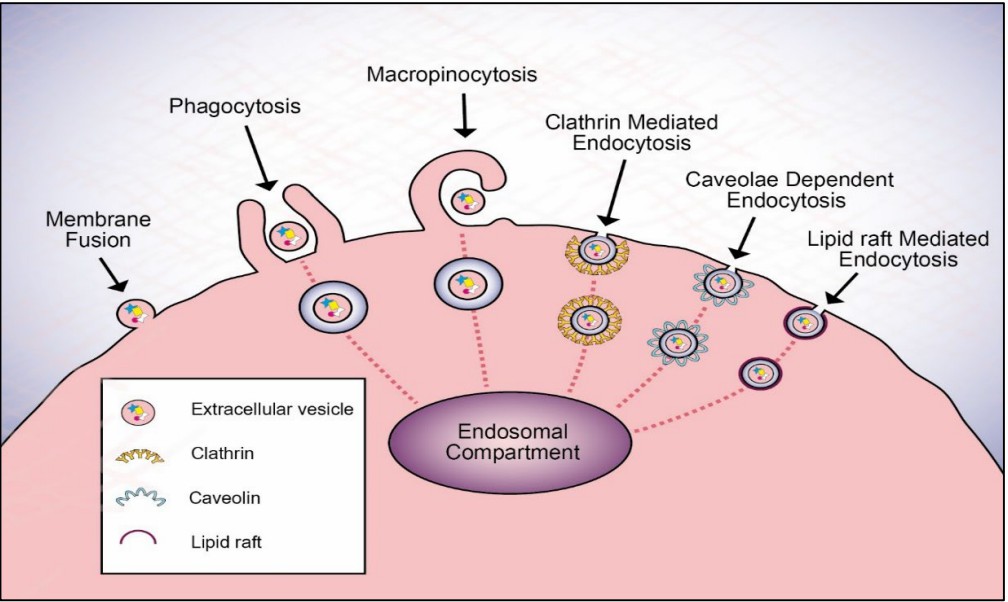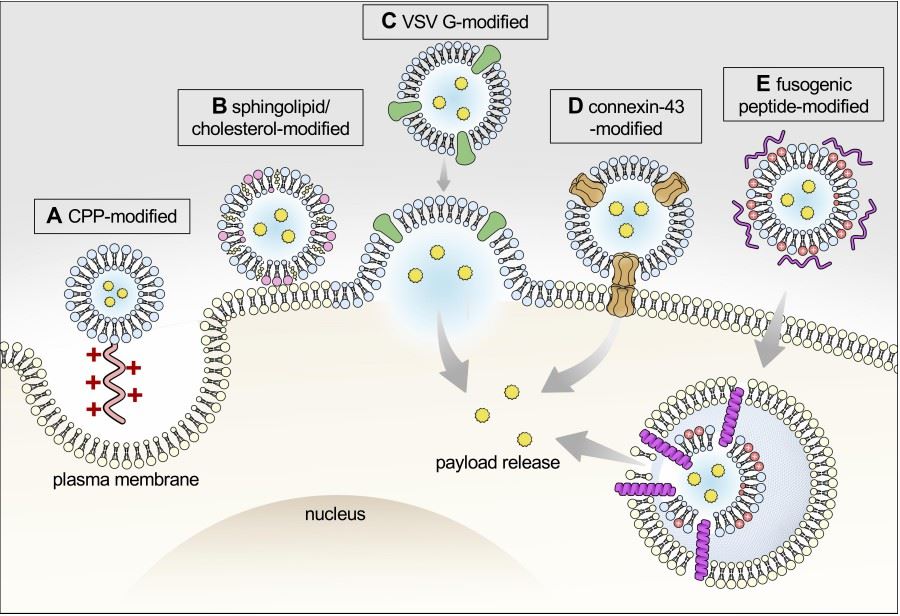Exosome Carrier-enhanced Cellular Internalization Advance Summary
The fusion of exosomes with recipient cells to deliver information molecules and induce relevant signaling pathways involves the recognition of exosomal surface molecules by the recipient cells. Modifying and regulating the composition of exosome surface molecules can affect cellular internalization and facilitate a variety of essential biological functions. Creative Biolabs has accumulated specialized insights and strategies for enhanced cellular internalization, providing services related to exosomes.
Patterns of Exosome Intracellularization
Exosome enrichment after cellular uptake affects the efficiency of the payload. There are three primary ways it interacts with the recipient cells:
-
Membrane fusion: The release of the exosome payload into the cytoplasm through a direct fusion of the membranes of the receptor cell and the exosome. During such fusion, a semi-fused stalk is formed between the hydrophobic lipid bilayer of the exosome and the plasma membrane, which then swells to form a single coherent structure.
-
Direct receptor interaction: This is where the transmembrane protein on the exosome surface binds directly to the protein receptor on the target cell. As this interaction occurs, downstream signaling cascades are induced and soluble ligands are released. Consequently, the exosome contents are selectively taken into the cell with permeable intracellular signals. It mediates immunomodulatory and apoptotic functions
-
Internalization: Exosomes are internalized by target cells and then fused with intracellular compartments or endosomal pathways to release cargo. This approach is mediated by the common endocytosis pathway. Reticulin-mediated endocytosis, lipid raft-mediated endocytosis, niche protein-mediated endocytosis, phagocytosis, and macrophage phagocytosis are among the pathways of exosome internalization.
 Fig.1 Extracellular vesicle (EV) internalization pathways into recipient cells. (Ginini, 2022)
Fig.1 Extracellular vesicle (EV) internalization pathways into recipient cells. (Ginini, 2022)
Enhanced Exosome Intracellularization Strategies
The identification of molecules on the exosome membrane's surface, which contains lipid rafts, membrane transport proteins, and transmembrane proteins, is necessary for exosome uptake and internalization by recipient cells. The membrane's lipid composition varies depending on the generating cells. Uptake of exosomes enables information transmission via proteins, nucleic acids, and other cargoes, allowing the recipient cell to undergo responses such as protein translation and signal regulation based on the information, thus altering the physiological condition. Therefore, in the pharmacokinetics of exosomes, their vesicle membrane components are critical in influencing the fate of the recipient cells and maintaining the functional stability of the microenvironment. Modifying exosome membrane fractions by performing operations such as surface display and genetic engineering are effective strategies to enhance their cellular internalization and payload delivery, including:
-
Equipment with penetrating peptides. Modification of exosomes with cell-penetrating peptides (e.g., arginine-rich peptides) can enhance the internalization of exosomes by stimulating cellular microphagocytosis.
-
Increasing membrane fusion. Increasing the membrane stiffness of exosomes by enriching them with sphingolipids and cholesterol can improve the fusion efficiency between exosomes and recipient cells, which can also be achieved by displaying vascular stomatitis virus (VSV-G) G protein on the exosome surface.
-
Integration with connexin-43. Connexin-43 forms hexagonal channels that allow exosomes to dock to slit junction pores in the plasma membrane, thereby enabling the direct cytoplasmic transfer of payload.
-
Enhanced escape from lysosomes. Integration of exosomes with a pH-sensitive fusion peptide (e.g., GALA peptide) facilitates exosome-endosome fusion in the endosomal transport route, helping to promote the escape of the exosomal load prior to degradation by the lysosome and stimulating the release of cargo in the cytoplasm.
 Fig.2 Approaches to enhance intracellular payload delivery. (Shao, 2020)
Fig.2 Approaches to enhance intracellular payload delivery. (Shao, 2020)
Uptake and internalization of exosomes undergo a finely regulated process involving multiple factors and phases, which are integral to targeting tissues and delivering cargo to tumors. Enhancing the cellular internalization of exosomes through surface modification is an exciting strategy to facilitate drug transfer and enhance drug efficacy. Creative Biolabs has accumulated insights to enhance the cellular internalization of exosomes and promote delivery efficiency, providing services related to exosome surface modification and cargo loading to help advance the development and research of exosome vehicles. Please contact us to discuss your project.
References
-
Ginini, L.; et al. Insight into extracellular vesicle-cell communication: from cell recognition to intracellular fate. Cells. 2022, 11(9): 1375.
-
Shao, J.; et al. Advances in exosome-based drug delivery and tumor targeting: from tissue distribution to intracellular fate. Int J Nanomedicine. 2020, 15: 9355-9371.
For Research Use Only. Cannot be used by patients.
Related Services:

 Fig.1 Extracellular vesicle (EV) internalization pathways into recipient cells. (Ginini, 2022)
Fig.1 Extracellular vesicle (EV) internalization pathways into recipient cells. (Ginini, 2022)
 Fig.2 Approaches to enhance intracellular payload delivery. (Shao, 2020)
Fig.2 Approaches to enhance intracellular payload delivery. (Shao, 2020)









